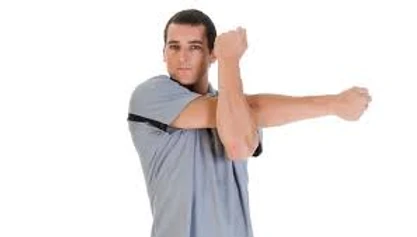Shoulder Impingement: Causes & How to Fix It

[et_pb_section fb_built="1" _builder_version="4.5.1" _module_preset="default"][et_pb_row _builder_version="4.5.1" _module_preset="default"][et_pb_column type="4_4" _builder_version="4.5.1" _module_preset="default"][et_pb_text _builder_version="4.5.1" _module_preset="default" hover_enabled="0"]
The shoulder joint is the most mobile joint in the body and is constantly challenged throughout the day, making it especially vulnerable to injury. Your shoulder is active during everyday tasks like reaching overhead into cabinets, lifting bags & boxes, and even more so during athletic activities that require both a large range of motion and high level of stability. Whether you are sitting at the desk for many hours each day or playing sports at a high level, well-developed and balanced musculature is needed to maintain a healthy and fully functional shoulder.
The most common cause of shoulder pain is known as shoulder impingement syndrome. There are two main types of shoulder impingement that can lead to reduced function and significant pain in the joint:
- External Shoulder Impingement
- Internal Shoulder Impingement
External Shoulder Impingement
External shoulder impingement syndrome is very common and occurs when the muscles of the rotator cuff, and potentially the bursa and biceps tendon become compressed between the head of the humerus and the tip of the shoulder blade known as the acromion process. This occurs in all individuals to some degree when we change positions and lift objects due to the anatomy of our shoulders.
The differentiating factor for those who get pain in their shoulder is the high degree of impingement that occurs. Simply put, more compression of the soft tissue (muscles, tendons, ligaments) in the small subacromial space will generally produce more pain, discomfort and potentially inflammation in and around the joint. Those with external shoulder impingement will commonly report a dull aching discomfort deep in the joint or in the
front portion of the shoulder.

External shoulder impingement typically occurs due to poor postural control leading to improper shoulder blade positioning, and muscle imbalances between the front and back of the shoulder girdle.

Provocative Movements for External Impingement
If you have pain in any of the positions below, there is a possibility you are experiencing symptomatic external shoulder impingement.
Hawkins-Kennedy Position

Empty Can Position

Cross Body Position

Shoulder Elevation/Neer’s Position

Internal Shoulder Impingement
Internal shoulder impingement is significantly less common than external impingement and typically affects overhead throwing athletes. Individuals with internal impingement syndrome will typically describe the discomfort as ‘inside’ the joint and will report pain occurring in the back & top portion of the shoulder. In this case the shoulder is only painful when it is fully externally rotated as if throwing a baseball or football. The pain also increases the further back the arm goes in this fully abducted and externally rotated position. While this condition is less common, both types of impingement are primarily caused by joint instability.

How Can We Fix It?
We can improve the symptoms and the underlying cause of external shoulder impingement by improving postural control and balancing shoulder girdle musculature. The simplest example of this is improving rotator cuff weakness. The muscles of the rotator cuff work together to move your arm in space and keep the head of the humerus centered in the joint. All muscle groups need to work together to achieve functional, pain free movement. If the rotator cuff is weakened, it may lose its ability to keep the head of the humerus centered allowing more powerful muscles like the deltoid to pull the bone upward and cause impingement of the rotator cuff muscles, specifically the supraspinatus.

While this is a common example, other reasons for symptomatic impingement include range of motion limitations in the neck, shoulder blade or upper back. All of these areas must work in union for healthy and successful shoulder movement to occur.
Action Steps to Take Today
1. Fix your forward shoulder posture
Thoracic Extension

Pectoral Stretch
\

2. Improve overhead shoulder range of motion
Lat Stretch

3. Improve shoulder and scapular strength and stability
Serratus Slide with Foam Roller

Banded External Rotation

With any injury, the most important thing to do is seek a comprehensive diagnosis and determine the root cause to reduce pain and limit long term effects. Seeking appropriate medical attention and intervention early on is the best way to feel better faster.
Article by Dr. Dylann Craig Germann, physical therapist at Eleven Eleven Wellness Center and owner of Impact Physical Therapy. If you are experiencing shoulder, neck or upper back discomfort and want to learn more, contact Impact Physical Therapy at (516) 603-9024 or email at ImpactPTNY@gmail.com.
[/et_pb_text][/et_pb_column][/et_pb_row][/et_pb_section]



















